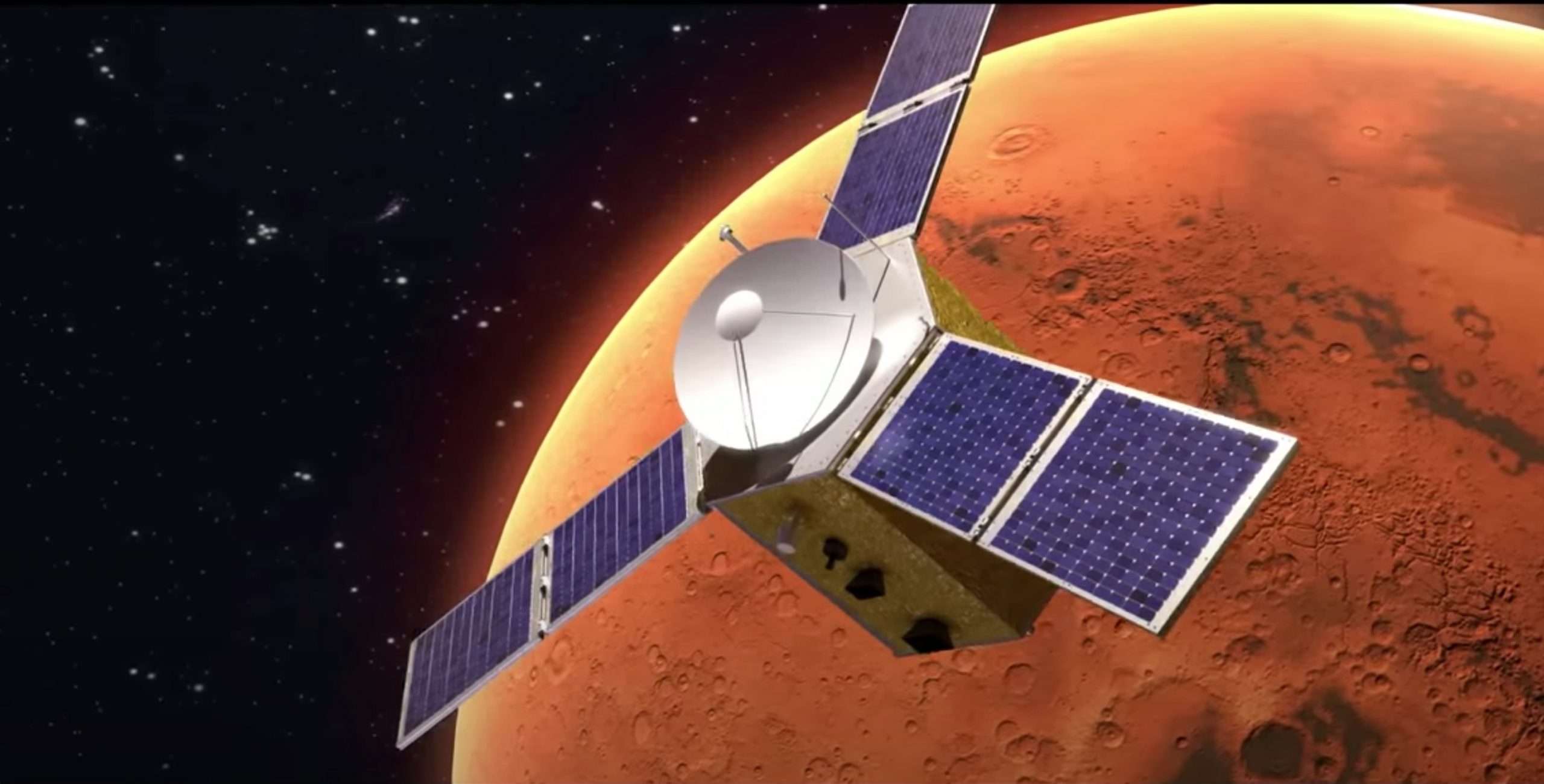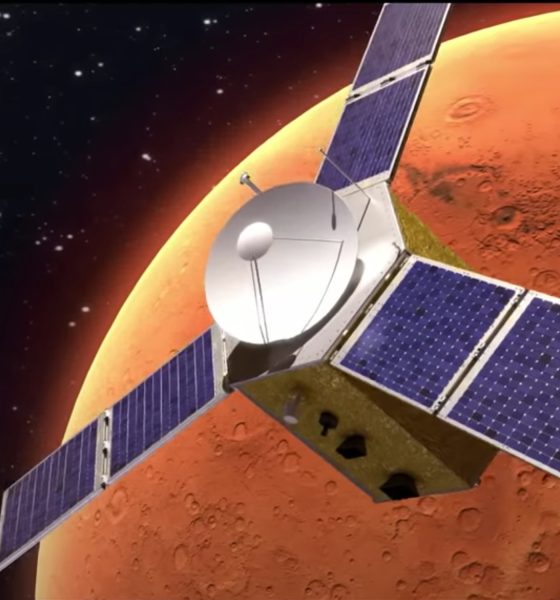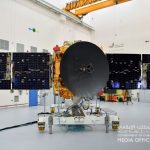

Space
United Arab Emirates enters Mars race with plans for summer mission
If all goes as planned, NASA’s Perseverance Mars rover will not be the only spacecraft headed to the red planet this summer. The United Arab Emirates Hope Mars mission, will join NASA’s newest Mars rover and a Chinese spacecraft, all set to launch in July.
“The Hope Probe project carries the hopes and ambitions of the Emirati nation and the aspirations of the Arab and Islamic people for a brighter future,” Sheikh Mohammed bin Rashid Al Maktoum, the prime minister of the UAE and Ruler of Dubai, said in a statement. “We seek to send a message of peace and hope to the world, and envision a glorious future in which knowledge and scientific expertise are freely shared between nations.”
The Hope Mars Mission, also called the Emirates Mars Mission, is the country’s first interplanetary satellite as well as the first planetary science mission to be led by an Arab-Islamic country. Like it’s Chinese and U.S. counterparts, the Hope mission wants to take advantage of this summer’s Mars window and launch sometime in July. If any of these missions cannot make its planned launch, the next window will open in 2022.
The European Space Agency (ESA), had also planned to launch its own Mars rover in July, but parachute complications combined with the global pandemic forced the agency to postpone until 2022. As of now, NASA is proceeding full steam ahead with the launch of Perseverance.
When it does launch, it will take the craft approximately eight months to reach the red planet. Once it arrives, Hope will be tasked with four main science objectives to better understand the Martian climate and atmosphere.
The craft will scan the atmosphere in search of any connections between the upper and lower atmosphere of Mars. It will also examine the mechanisms behind the loss of Mars’ atmosphere. The loss of atmosphere is considered to be one of the main factors in now Mars transformed from a lush, wet planet similar to Earth to the barren, desert world we see today.

Researchers hope that the spacecraft will help them better understand how the Martian atmosphere evolved over time and allow them to create a global picture of the atmosphere. One of the mission’s goals is to document variations in the atmosphere both seasonally and yearly.
The mission is a collaboration between the UAE and researchers at the University of Colorado, Arizona State University, and University of California. It will launch from Japan and collect data for two years. If all goes as planned, its extended mission could last until 2025. The probe aims to revolutionize our understanding of the Martian atmosphere, by identifying layers within the planet’s atmosphere as measure how fast the atmosphere is being lost to space.
- The UAE finished construction on its Hope spacecraft, bound for Mars, earlier this year. Credit: Government of Dubai Media Office
- Artist rendition of the UAE’s Hope satellite in space. Credit: UAE Space Agency
Construction on the interplanetary probe was completed earlier this year. The spacecraft’s arrival at Mars will coincide with the 50th anniversary of the UAE’s formation. It will also mark another historic spaceflight milestone for the country. (The previous achievement came in September 2019, when the country’s first astronaut launched to the International Space Station.)
Hope will also serve as a first toward a larger goal of building a habitable settlement on Mars by 2117.
“Reaching Mars is not impossible for us,” Sheikh Hamdan bin Mohammed bin Rashid Al Maktoum, a crown prince of Dubai and the chairman of the Mohammed bin Rashid Space Centre, said in the same statement. “The word ‘impossible’ has no place in our dictionary.”

News
SpaceX shades airline for seeking contract with Amazon’s Starlink rival

SpaceX employees, including its CEO Elon Musk, shaded American Airlines on social media this past weekend due to the company’s reported talks with Amazon’s Starlink rival, Leo.
Starlink has been adopted by several airlines, including United Airlines, Qatar Airways, Hawaiian Airlines, WestJet, Air France, airBaltic, and others. It has gained notoriety as an extremely solid, dependable, and reliable option for airline travel, as traditional options frequently cause users to lose connection to the internet.
Many airlines have made the switch, while others continue to mull the options available to them. American Airlines is one of them.
A report from Bloomberg indicates the airline is thinking of going with a Starlink rival owned by Amazon, called Leo. It was previously referred to as Project Kuiper.
American CEO Robert Isom said (via Bloomberg):
“While there’s Starlink, there are other low-Earth-orbit satellite opportunities that we can look at. We’re making sure that American is going to have what our customers need.”
Isom also said American has been in touch with Amazon about installing Leo on its aircraft, but he would not reveal the status of any discussions with the company.
The report caught the attention of Michael Nicolls, the Vice President of Starlink Engineering at SpaceX, who said:
“Only fly on airlines with good connectivity… and only one source of good connectivity at the moment…”
CEO Elon Musk replied to Nicolls by stating that American Airlines risks losing “a lot of customers if their connectivity solution fails.”
American Airlines will lose a lot of customers if their connectivity solution fails
— Elon Musk (@elonmusk) December 14, 2025
There are over 8,000 Starlink satellites in orbit currently, offering internet coverage in over 150 countries and territories globally. SpaceX expands its array of satellites nearly every week with launches from California and Florida, aiming to offer internet access to everyone across the globe.
Currently, the company is focusing on expanding into new markets, such as Africa and Asia.
News
Tesla hints at Starlink integration with recent patent
“By employing polymer blends, some examples enable RF transmission from all the modules to satellites and other communication devices both inside and outside the vehicle.”

Tesla hinted at a potential Starlink internet terminal integration within its vehicles in a recent patent, which describes a vehicle roof assembly with integrated radio frequency (RF) transparency.
The patent, which is Pub. No U.S. 2025/0368267 describes a new vehicle roof that is made of RF-transparent polymer materials, allowing and “facilitating clear communication with external devices and satellites.”
Tesla believes that a new vehicle roof design, comprised of different materials than the standard metallic or glass elements used in cars today, would allow the company to integrate modern vehicular technologies, “particularly those requiring radio frequency transmission and reception.
Tesla has recently filed a US patent application on integrating RF transparent materials into the roof structure.
“facilitating clear communication with external devices and satellites”
Tesla fleet is getting @Starlink connectivity integration soon. LFG @Tesla @elonmusk… pic.twitter.com/bLa8YtPLd1
— Chansoo Byeon (@Chansoo) December 9, 2025
Instead of glass or metallic materials, Tesla says vehicles may benefit from high-strength polymer blends, such as Polycarbonate, Acrylonitrile Butadiene Styrene, or Acrylonitrile Styrene Acrylate.
These materials still provide ideal strength metrics for crashworthiness, stiffness for noise, vibration, and harshness control, and are compliant with head impact regulations.
They would also enable better performance with modern technologies, like internet terminals, which need an uninterrupted signal to satellites for maximum reception. Tesla writes in the patent:
“By employing polymer blends, some examples enable RF transmission from all the modules to satellites and other communication devices both inside and outside the vehicle.”

One of the challenges Tesla seems to be aware of with this type of roof design is the fact that it will still have to enable safety and keep that at the forefront of the design. As you can see in the illustration above, Tesla plans to use four layers to increase safety and rigidity, while also combating noise and vibration.
It notes in the patent that disclosed examples still meet the safety requirements outlined in the Federal Motor Vehicle Safety Standards (FMVSS).
Starlink integrated directly into Tesla vehicles would be a considerable advantage for owners. It would come with a handful of distinct advantages.
Initially, the inclusion of Starlink would completely eliminate cellular dead zones, something that is an issue, especially in rural areas. Starlink would provide connectivity in these remote regions and would ensure uninterrupted service during road trips and off-grid adventures.
It could also be a critical addition for Robotaxi, as it is crucial to have solid and reliable connectivity for remote monitoring and fleet management.
Starlink’s growing constellation, thanks to SpaceX’s routine and frequent launch schedule, will provide secure, stable, and reliable internet connectivity for Tesla vehicles.
Although many owners have already mounted Starlink Mini dishes under their glass roofs for a similar experience, it may be integrated directly into Teslas in the coming years, either as an upgrade or a standard feature.
Investor's Corner
SpaceX IPO is coming, CEO Elon Musk confirms
However, it appears Musk is ready for SpaceX to go public, as Ars Technica Senior Space Editor Eric Berger wrote an op-ed that indicated he thought SpaceX would go public soon. Musk replied, basically confirming it.

Elon Musk confirmed through a post on X that a SpaceX initial public offering (IPO) is on the way after hinting at it several times earlier this year.
It also comes one day after Bloomberg reported that SpaceX was aiming for a valuation of $1.5 trillion, adding that it wanted to raise $30 billion.
Musk has been transparent for most of the year that he wanted to try to figure out a way to get Tesla shareholders to invest in SpaceX, giving them access to the stock.
He has also recognized the issues of having a public stock, like litigation exposure, quarterly reporting pressures, and other inconveniences.
However, it appears Musk is ready for SpaceX to go public, as Ars Technica Senior Space Editor Eric Berger wrote an op-ed that indicated he thought SpaceX would go public soon.
Musk replied, basically confirming it:
As usual, Eric is accurate
— Elon Musk (@elonmusk) December 10, 2025
Berger believes the IPO would help support the need for $30 billion or more in capital needed to fund AI integration projects, such as space-based data centers and lunar satellite factories. Musk confirmed recently that SpaceX “will be doing” data centers in orbit.
AI appears to be a “key part” of SpaceX getting to Musk, Berger also wrote. When writing about whether or not Optimus is a viable project and product for the company, he says that none of that matters. Musk thinks it is, and that’s all that matters.
It seems like Musk has certainly mulled something this big for a very long time, and the idea of taking SpaceX public is not just likely; it is necessary for the company to get to Mars.
The details of when SpaceX will finally hit that public status are not known. Many of the reports that came out over the past few days indicate it would happen in 2026, so sooner rather than later.
But there are a lot of things on Musk’s plate early next year, especially with Cybercab production, the potential launch of Unsupervised Full Self-Driving, and the Roadster unveiling, all planned for Q1.










